Manhole for sewage: installation of a well in storm and sewage systems
An extensive sewer network consisting of pipelines is located underground. I want her important nodes to be accessible for maintenance, right? For these purposes, you decided to equip such an element of the system as a manhole for sewage, but do not know where to start?
We will try to help - in this material the device of this type of structure is examined in detail, important nuances that should be taken into account when self-assembling. There is also an instruction for arranging with your own hands, in which step-by-step photos of the workflow are selected for clarity.
In order to make it easier for a novice in this business to understand the topic of constructing a well to control the sewer network, we have added videos about installing manholes from various materials.
The content of the article:
Purpose of underground observation chambers
The sewer circuit is designed for the rapid removal of domestic wastewater, rain and melt water into specially designated settling tanks, sewer wells or collectors. Viewing wells are installed on the most critical sections of the sewer network.
For the equipment of a straight line with a length of 10 m, the construction of an additional camera is irrational, whereas on a 100-meter section with intersection nodes, forced turns and level differences, control points are simply necessary.
They make it possible to freely check the functions of a pipeline located at a depth of 2 m and below, and in case of breakage, quickly repair it. In a specially equipped chamber, all shut-off and control valves are in full view, so it is not difficult to replace worn parts with new ones.

An accident in an underground network section that is not equipped with an inspection well is eliminated by excavation (including the use of heavy construction equipment). It is harder, longer and more expensive.
Examination cameras also help pinpoint the location of a leak.
Mankind has been engaged in arranging revision underground chambers for hundreds of years - from the time when the first communication systems for moving water appeared.
During this period, there were rules for the construction of special facilities, which are currently set out in documents such as SNiP and GOST.
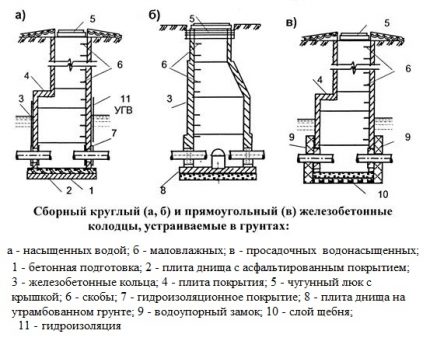
For instance, paragraph 2.04.03-85 (SNiP) called “Sewerage. External networks and structures ”, reveals the rules for the construction of inspection wells. The article contains information on where it is necessary to arrange these objects, how to choose the right sizes.
Accepted standards help integrate different networks into one inextricable design and simplify installation.
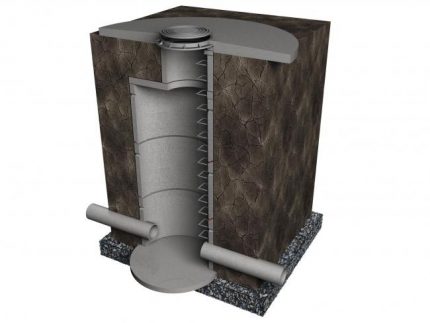
Types of sewer wells
Varieties of manholes are distinguished based on two factors:
- main function and installation location;
- manufacturing material.
According to the first factor, there are linear, nodal, rotary and differential types. They are equally applicable to both domestic and industrial communication systems.
This means that any of these types, if necessary, for example, due to the large length of the sewer pipeline, can install on your site.
Linear is installed on a direct pipeline. They are equipped with one pair of nozzles or outlet openings, which are located opposite each other.
Such wells are necessary, even if there are no prerequisites for an emergency, but the site is recognized as quite long (according to SNiP - from 35 m to 300 m).
Swivel types, as the name implies, are mounted on pipelines that turn to the side. The general rule applies: the angle of rotation should not exceed 90º, that is, it should not be sharp.
Pipes (holes) are not on the same line, but in places that depend on the angle of rotation, but at the same level in height.
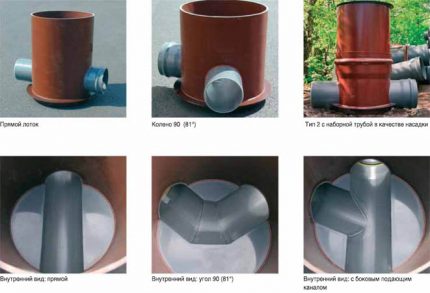
Nodal models are mounted at the intersection of two or more pipelines, as well as where the center line has branches.
Wells differ structurally by the presence of additional nozzles (holes). As a rule, all inputs / outputs are on the same level.
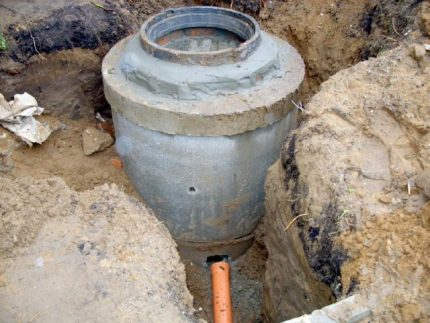
Overflow pipes are used to increase or decrease the flow, so the pipes are located at different levels: the supply pipe is usually higher, closer to the neck, the discharge pipe - below. The device of overflow wells is also resorted to if necessary to reduce the speed of transportation of effluents.
Despite the functional and structural differences, all types of wells are very similar. They are made from various materials.
Initially, stone and brick were considered the best, now there are practically no stone structures left. They were replaced by practical and easier to install concrete counterparts.
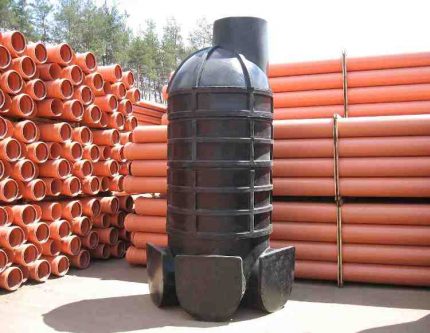
Reinforced concrete plants produce standard parts, from which they stack individual chambers during installation: they simply install the individual elements on top of each other, then seal the seams.
The modern analogue of concrete wells is polymer models, which are corrugated containers and are particularly durable and leakproof.
Location depending on destination
According to the norms of SNiP, there are points of mandatory installation of revision cameras:
- in places of turns and slopes, when changing the direction of the linear pipeline;
- in places of accession to the central line of additional branches;
- in areas of changing the diameter of the pipes.
The entrances of private sewer networks to the central system (or collector) are also equipped with viewing cameras.
The diameter of the pipes directly depends on the length of the linear section. For example, a pipeline up to 35 m long consists of elements with a diameter of 150 mm, a hundred-meter section consists of pipes with a diameter of 700 to 900 mm, the maximum possible 300-meter line consists of pipes whose diameter can be more than 2 m.
The dependence is the opposite, that is, if the diameter of the pipeline is 150 mm, then after 35 meters, a well installation is necessary.
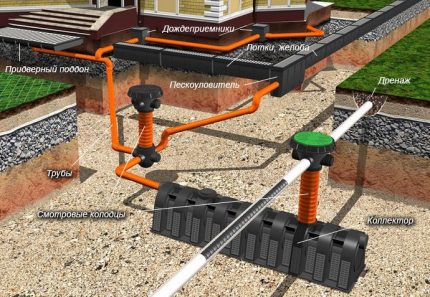
The most difficult site is selected and the revision chamber is mounted.Most often, this is the place for inserting an additional sleeve, for example, coming from the bath.
Viewing wells for private use may differ from their industrial counterparts in size or number of nozzles, but do not have a fundamental difference.
Features of designs of various types
Requirements for reinforced concrete prefabricated structures are set out in regulatory documents GOST 2080-90, where the technical requirements for the products are described in detail, their characteristics, marking and references to related GOST articles are given.
The advantages of prefabricated buildings over monolithic are installation options. Reinforced concrete parts are heavy, so they have to be transported and installed using special equipment. It is much more convenient to ensure the delivery of individual parts than the entire structure in finished form.
During installation, additional measures are sometimes required - for example, the installation of a waterproof lock. Assembling the structure in parts, it is much easier to carry out specific earthwork.
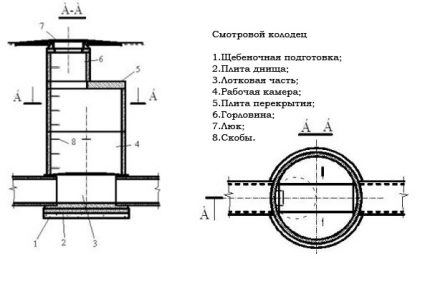
So, the lower part of the structure is a solid concrete slab, which is placed on a previously prepared base. To give the structure stability and at the same time ensure the outflow of groundwater, crushed stone is poured into the pit before installation. The bottom plate is laid on the crushed stone base strictly horizontally.
The lower part is called the tray, it is equipped with holes or nozzles for mounting the pipeline. The location of the inlets depends on the purpose of the well. Suppose in linear structures they are on opposite sides, in rotary ones depending on the angle of rotation.
The main working chamber is larger than the others in size - it is in it that you should go down to check the valves, the tightness of the joints or worn parts. For ease of descent, one wall is equipped with a ladder made of metal staples.
From above, the working chamber is covered by a slab, to which another element is attached - the neck. In diameter, it is already the main part.
Neck hides behind, which performs two functions - protects the well from the penetration of unwanted guests and protects from street debris and rain. To complicate getting into the chamber, the hatch is made of heavy material - cast iron.
When installing viewing cameras in a suburban area, it is not necessary to use cast-iron parts. Now they produce many kinds polymer capsmore comfortable and aesthetically pleasing.
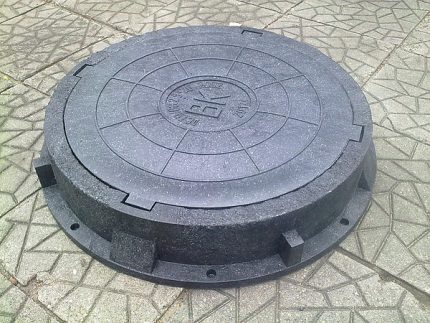
Requirements for the construction of polymer products are described in GOST-R No. 0260760. One of the common manufacturing materials is polyethylene. Reliability of the design is ensured by the production technology - extrusion welding method.
Products are not susceptible to chemicals present in the soil, are characterized by wear resistance, environmental friendliness and tightness.
Outwardly, they resemble large capsules with a hole in the neck. Unlike concrete counterparts, plastic cameras acquire and install ready-made.
Products are adapted for quick installation and connection of pipes. Thanks to the easy installation, many owners of suburban housing prefer plastic cameras.
Dimensions of concrete structures
A full list of standard sizes can be found in regulatory documents, for example, in Article 2.04.03-85 SNiP. Dimensions relate to the values of the various parts of the structure and the incoming pipes, as well as the distances between them.
If the diameter of the passing pipe is 600 mm or less, length and width wells made of concrete rings should correspond to 1 m.
With increasing diameter, the dimensions of the chamber increase:
- for rectangular reinforced concrete products - pipe D 700 mm = well D + 400 mm;
- for round reinforced concrete products - pipe D 700 mm = well D 1250 mm, up to 1000 mm = 1500 mm, more than 1200 mm = 2000 mm.
There are types of wells that are not intended for descent. If the communications are at a depth of 100-120 cm, and the diameter of the pipeline is 15 cm, a compact viewing chamber with a diameter of only 60 cm is suitable.
It serves for cleaning procedures. These products are often used in cottages, for the device of a small along the length of storm sewers.
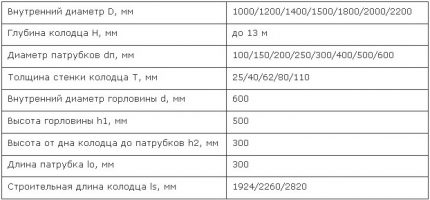
The height of the working chamber is 1.8 m, however, there are models with reduced dimensions. Width - not less than 1.0 m. The diameter of the neck is 0.7 m. The dimensions of all parts of the well must be such that the worker can freely go inside and carry out repair or cleaning procedures.
The hatch is usually on the same level as the roadway or pavement, on the lawn it rises 5-7 cm above the ground level, and 20 cm in the undeveloped area.
If necessary, a locking device is installed on the lid. One of the main conditions for sizing is the safe operation of manholes.
Solving installation issues
If you decide to lay the sewer network yourself, first study the norms of SNiP and the requirements for installing all elements of the system.
This applies to manhole for stormwater. They are necessary even if the underground pipeline is laid around the perimeter of the cottage - each corner turn is equipped with an inspection chamber.
Option # 1 - assembly of concrete rings
A place for installation is planned at the stage of designing the project, so the preparatory work comes down to the following activities:
- precise marking of the area for digging a pit;
- cleaning the territory from trees, shrubs, garbage;
- the construction of a temporary entrance for equipment (if necessary, the dismantling of obstructing buildings).
When the territory is liberated, we begin to dig a pit - we get the soil to the required depth (height of the structure + pillow from crushed stone).
We level the bottom, fill it with a 20 cm layer of crushed stone, tamp it, if necessary, seal it with bitumen mastic. The foundation pit is completely ready for the installation of a reinforced concrete well.
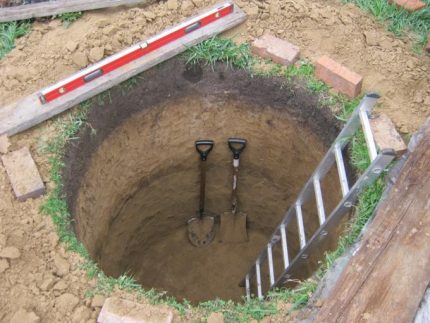
Next, we act according to the following plan:
- We lay the foundation (ready-made concrete slab or home-made pillow in the form of a 10-centimeter screed made of concrete M-50).
- We equip the tray - we form the lower part from M-100 concrete, we strengthen it with a galvanized steel mesh.
- The ends of the pipes are sealed with layers of cement and bitumen.
- After 2-3 days, we process concrete rings from the inside with bitumen and install on the tray part.
- We mount the floor slab, the neck, we seal everything.
- We grout the joints with cement mortar and bitumen (in SNiP 6.3.8 it is indicated that in the presence of groundwater waterproofing is necessary 50 cm above their surface).
- Plastering the tray.
- We equip the clay castle at the bottom (30 cm wide, 60 cm above the D pipes).
- We check the quality of the waterproofing - fill it with water and leave it for a day (we close the exits with plugs).
At one stage we connect the pipes.
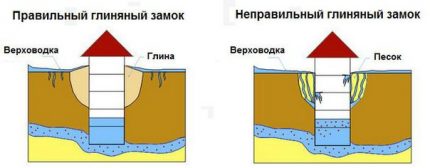
After a successful check, we make backfill, in the upper part we make a blind area (one and a half meters along the neck diameter).
We leave the upper part open by installing a locking mechanism on the hatch, or mask it - close it with a decorative polymer cover.
Option # 2 - installation of a plastic well
Installing a plastic camera is faster and easier. Preparatory work is carried out according to the same plan as for the construction of a concrete structure.
The main thing is to comply with the installation standards, which can be clarified by the manufacturer or the specialists of the company selling the product.
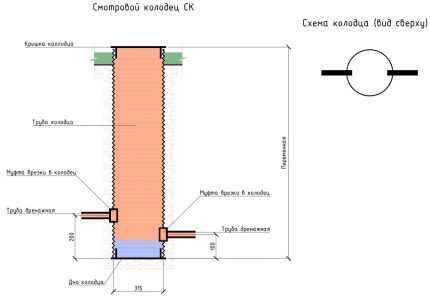
Stages of the device of the polymer viewing well:
- Digging a pit by excavating to the required depth (the width should exceed the size of the chamber by 20 cm in all directions).
- Arrangement of the base: filling the filtering layer of crushed stone, the leveling layer of sand (15-20 cm).
- Installation of a plastic well on a prepared base.
- Connection of the sewer pipeline.
- Backfill with interval tamping (every 3-5 cm).
Sometimes cement is added to the sand for backfill. The seal protects against movement in watered soils. Some models, due to their lightness, are equipped with a load chamber (or several cameras), into which concrete is poured during installation. A kind of anchor provides stability during the movement of groundwater.
Separately, it is worth mentioning the features of the installation of a polyethylene well under the sidewalk (garden path) or road (roadway). In order for the walls to withstand the load and not collapse, the installation of reinforced concrete plates is provided.
Over time, with deformation of the roadway, plates will shift, and the well will remain in its original position.
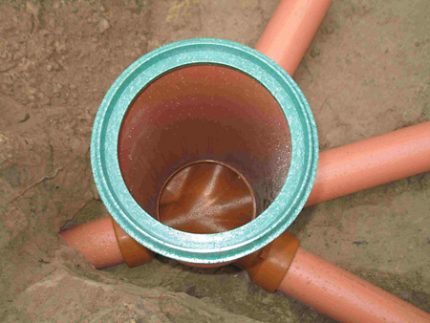
For protection, two concrete slabs with reinforcement will be required. In the center of the bottom plate there is a hole exceeding the diameter of the chamber by 1.5-2 cm.
The well is lowered into the hole so that it is 9 cm higher than the bottom of the polyethylene product. The top plate resembles a conventional ceiling with a hole for the hatch, which is located strictly above the stairs, that is, offset from the central axis.
Polymer wells in conjunction with plastic pipes form a reliable system, wear-resistant and environmentally friendly, capable of serving for decades.
You may also be interested in the information about polymer sand wells, discussed in detail in this article.
The nuances of waterproofing
Manholes are considered to be dry type processing facilities, which are most often found in moist soils.
When constructing these structures waterproofing is an obligatory measure guaranteeing the safety of pipeline fittings and effective work on cleaning or flushing pipes.
Practice shows that leaks in prefabricated concrete structures occur most often not because of defects in products, but because of improper processing of joints. This means that joint repair is a serious and responsible procedure.
As waterproofing compositions, 3 types of insulation are used:
- bitumen-polymer;
- cement-polymer;
- polymer.
Bitumen-polymer waterproofing includes coating materials (mastics) and surfaced rolls, for gluing of which it is necessary to heat to a certain temperature. The second option is used less often, since special skills in the use of a gas burner are necessary.
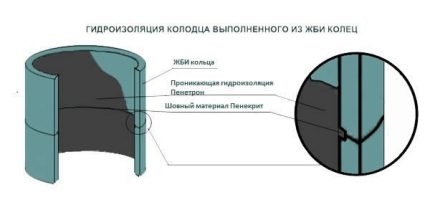
Cement-polymer compositions are cheaper, have excellent technical characteristics and are suitable for independent use. The prepared mixture is applied with a spatula in 2-3 layers on a moistened cleaned surface, leveled and allowed to dry.
Polymer waterproofing is flexible and durable. Mastics and roll membranes are ideally suited for potentially moving structures - even with a slight displacement, the joint sealing will be preserved.
In addition to the walls, it is necessary to isolate the base of the well. Usually it is produced at the stage of laying a concrete slab, before mounting the rings. The plate is covered with a cement-polymer composition, the lower joints are also coated with it.
Conclusions and useful video on the topic
Materials from the videos will help you choose and install inspection wells for sewers correctly.
Interesting information about polymer sand wells:
Installation of concrete rings for a drainage well:
Installation of a plastic well:
Drainage system for a summer residence:
The device of the inspection well resembles the construction of other types of sewer structures - filtration or storage. However, there are some nuances that you need to get to know before starting installation.
In order not to make a mistake in choosing products and installation technology, refer to regulatory documents and consult with professionals.
Do you have experience building an inspection sewer well? Or do you just want to tackle its arrangement? Perhaps you still have questions after reading the material? Ask for advice or leave your recommendations in the comment block located at the bottom of the article.

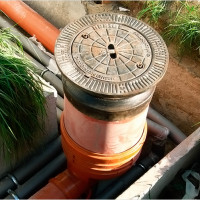 How to make a drainage well with your own hands and bring pipes to it
How to make a drainage well with your own hands and bring pipes to it 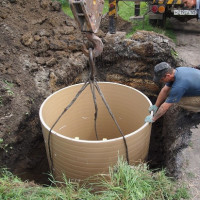 Viewing wells for drainage: types, arrangement and installation features
Viewing wells for drainage: types, arrangement and installation features 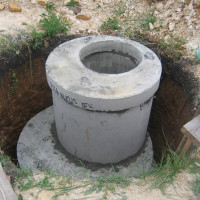 How to make a sewer well: do-it-yourself installation and installation
How to make a sewer well: do-it-yourself installation and installation 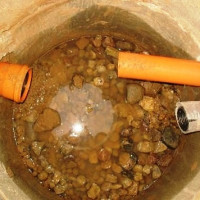 Filter well: design, purpose, device technology
Filter well: design, purpose, device technology 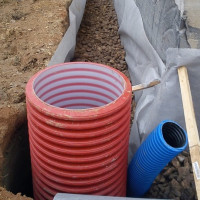 Plastic wells for drainage: device, types, classification, installation instructions
Plastic wells for drainage: device, types, classification, installation instructions 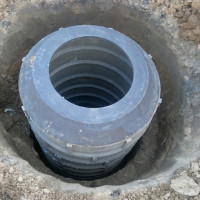 Polymer-sand wells: device, advantages and disadvantages, installation rules
Polymer-sand wells: device, advantages and disadvantages, installation rules  How much does it cost to connect gas to a private house: the price of organizing gas supply
How much does it cost to connect gas to a private house: the price of organizing gas supply  The best washing machines with dryer: model rating and customer tips
The best washing machines with dryer: model rating and customer tips  What is the color temperature of light and the nuances of choosing the temperature of the lamps to suit your needs
What is the color temperature of light and the nuances of choosing the temperature of the lamps to suit your needs  Replacement of a geyser in an apartment: replacement paperwork + basic norms and requirements
Replacement of a geyser in an apartment: replacement paperwork + basic norms and requirements